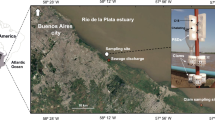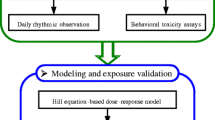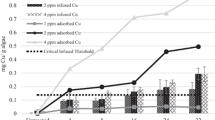Abstract
Freshwater clam Corbicula fluminea, a surrogate species in metal toxicity testing, is a promising bioindicator of impairment in aquatic ecosystems. Little is known, however, about the relationship between clam valve daily rhythmic response and metal bioavailability related to a metal biological early warning system (BEWS) design. The purpose of this study was to link biotic ligand model (BLM)-based bioavailability and valve daily rhythm in C. fluminea to design a biomonitoring system for online in situ detection of waterborne copper (Cu). We integrated the Hill-based dose-time-response function and the fitted daily rhythm function of valve closure into a constructed programmatic mechanism. The functional presentation of the present dynamic system was completely demonstrated by employing a LabVIEW graphic control program in a personal computer. We used site-specific effect concentration causing 10% of total valve closure response (EC10) as the detection threshold to implement the proposed C. fluminea-based Cu BEWS. Here our results show that the proposed C. fluminea-based BEWS could be deliberately synthesized to online in situ transmit rapidly the information on waterborne bioavailable Cu levels under various aquatic environmental conditions through monitoring the valve daily rhythmic changes. We suggested that the developed C. fluminea-based dynamic biomonitoring system could assist in developing technically defensible site-specific water quality criteria to promote more efficient uses in water resources for protection of species health in aquatic environments.
Similar content being viewed by others

References
Borcherding, J., & Volpers, M. (1994). The “Dreissena-monitor”—first results on the application of this biological early warning system in the continuous monitoring of water quality. Water Science and Technology, 29, 199–201.
Byrne, R., Gnaiger, E., McMahon, R., & Dietz, T. (1990). Behavioral and metabolic responses to emersion and subsequent reimmersion in the freshwater bivalve Corbicula fluminea. The Biological Bulletin, 178, 251–259. doi:10.2307/1541826.
Cherry, D. S., & Soucek, D. J. (2006). Case study: Comparison of Asian clam (Corbicula fluminea) in situ testing to several nontarget test organism responses to biocidal dosing at a nuclear power plant. In J. L. Farris, J. H. Van Hassel (Eds.), Freshwater bivalve ecotoxicology (pp. 285–305). Roca Raton: CRC.
Curtis, T. M., Williamson, R., & Depledge, M. H. (2000). Simultaneous, long-term monitoring of valve and cardiac activity in the blue mussel Mytilus edulis exposed to copper. Marine Biology (Berlin), 136, 837–846. doi:10.1007/s002270000297.
Dohery, F. G., & Cherry, D. S. (1988). Tolerance of the Asiatic clam Corbicula-spp to lethal levels of toxic stressors—a review. Environmental Pollution, 51, 269–313. doi:10.1016/0269-7491(88)90167-4.
Doherty, F. G., Cherry, D. S., & Cairns, J. Jr. (1987). Valve closure responses of the Asiatic clam C. fluminea exposed to cadmium and zinc. Hydrobiologia, 153, 159–167. doi:10.1007/BF00006647.
Englund, M. P. V., & Heino, P. M. (1994). Valve movement of Anodonta anatina and Unio tumidus (Bivlvia, Unionidae) in a eutrophic lake. Annales Zoologici Fennici, 31, 257–262.
Fournier, E., Tran, D., Denison, F., Massabuau, J.-C., & Garnier-Laplace, J. (2004). Valve closure response to uranium exposure for a freshwater bivalve (Corbicula fluminea): Quantification of the influence of pH. Environmental Toxicology and Chemistry, 23, 1108–1114. doi:10.1897/02-604.
Heinonen, J., Penttinen, O. P., Holopainen, I. J., & Kukkonen, J. V. K. (2003). Sublethal energetic responses by Pisidium amnicum (Bivalvia) exposed to pentachlorophenol at two temperatures. Environmental Toxicology and Chemistry, 22, 433–438. doi:10.1897/1551-5028(2003)022<0433:SERBPA>2.0.CO;2.
Higgins, P. J. J. (1980). Effects of food availability on the valve movement and feeding behaviour of juvenile Crassostrea virginica (Gmelin). I. Valve movement and periodic activity. Journal of Experimental Marine Biology and Ecology, 45, 229–244. doi:10.1016/0022-0981(80)90060-X.
Jou, L. J., & Liao, C. M. (2006). A dynamic artificial clam (Corbicula fluminea) allows parsimony on-line measurement of waterborne metals. Environmental Pollution, 144, 172–183. doi:10.1016/j.envpol.2005.12.032.
Kadar, E., Salanki, J., Jugdaohsingh, R., Powell, J. J., McCrohan, C. R., & White, K. N. (2001). Avoidance responses to aluminium in the freshwater bivalve Anodonta cygnea. Aquatic Toxicology (Amsterdam, Netherlands), 55, 137–148. doi:10.1016/S0166-445X(01)00183-7.
Le Pennec, G., & Le Pennec, M. (2001). Evaluation of the toxicity of chemical compounds using digestive acini of the bivalve mollusk Pecten maximus L. maintained alive in vitro. Aquatic Toxicology (Amsterdam, Netherlands), 53, 1–7. doi:10.1016/S0166-445X(00)00163-6.
Liao, C. M., Jou, L. J., & Chen, B. C. (2005). Risk-based approach to appraise valve closure in the clam Corbicula fluminea in response to waterborne metals. Environmental Pollution, 135, 41–52. doi:10.1016/j.envpol.2004.10.015.
Liao, C. M., Jou, L. J., Lin, C. M., Chiang, K. C., Chou, B. Y. H., & Yeh, C. H. (2007). Predicting acute copper toxicity to valve closure behavior in the freshwater clam Corbicula fluminea supports the biotic ligand model. Environmental Toxicology, 22, 295–307. doi:10.1002/tox.20263.
Lopez-Barea, J., & Pueyo, C. (1998). Mutagen content and metabolic activation of promutagens by molluscs as biomarkers of marine pollution. Mutation Research, 399, 3–15. doi:10.1016/S0027-5107(97)00262-5.
Markich, S. J. (2003). Influence of body size and gender on valve movement responses of a freshwater bivalve to uranium. Environmental Toxicology, 18, 126–136. doi:10.1002/tox.10109.
Mitchelmore, C. L., & Chipman, J. K. (1998). DNA strand breakage in aquatic organism and potential values of the comet assay in environmental monitoring. Mutation Research, 399, 135–147. doi:10.1016/S0027-5107(97)00252-2.
Narbonne, J. F., Djomo, J. E., Ribeira, F. V., & Garrigues, P. (1999). Accumulation kinetics of polycyclic aromatic hydrocarbons adsorbed to sediment by the mollusk Corbicula fluminea. Ecotoxicology and Environmental Safety, 42, 1–8. doi:10.1006/eesa.1998.1701.
Niyogi, S., & Wood, C. M. (2004). Biotic ligand model, a flexible tool for developing site-specific water quality guidelines for metals. Environmental Science & Technology, 38, 6177–6192. doi:10.1021/es0496524.
Ortmann, C., & Grieshaber, M. K. (2003). Energy metabolism and valve closure behaviour in the Asian clam Corbicula fluminea. The Journal of Experimental Biology, 206, 4167–4178. doi:10.1242/jeb.00656.
Paquin, P. R., Gorsuch, J. W., Apte, S., Batley, G. E., Bowles, K. C., Campbell, P. G. C., et al. (2002). The biotic ligand model: A historical overview. Comparative Biochemistry and Physiology, 133(Part C), 3–35.
Pynnonen, K. (1990). Aluminium accumulation and distribution in the freshwater clams (Unionidae). Comparative Biochemistry and Physiology, 97(Part C), 111–117. doi:10.1016/0742-8413(90)90180-H.
Sluyts, H., Van Hoof, F., Cornet, A., & Paulussen, J. (1996). A dynamic new alarm system for use in biological early warning systems. Environmental Toxicology and Chemistry, 15, 1317–1323. doi:10.1897/1551-5028(1996)015<1317:ADNASF>2.3.CO;2.
Snoeyink, V. L., & Jenkins, D. (1980). Water chemistry. New York: Wiley.
Tran, D., Ciret, P., Ciutat, A., Durrieu, G., & Massabuau, J. C. (2003). Estimation of potential and limits of bivalve closure response to detect contaminants: Application to cadmium. Environmental Toxicology and Chemistry, 22, 914–920. doi:10.1897/1551-5028(2003)022<0914:EOPALO>2.0.CO;2.
Tran, D., Fournier, E., Durrieu, G., & Massabuau, J. C. (2004). Copper detection in the Asiatic clam Corbicula fluminea: Optimum valve closure response. Aquatic Toxicology (Amsterdam, Netherlands), 66, 333–343. doi:10.1016/j.aquatox.2004.01.006.
Tran, D., Fournier, E., Durrieu, G., & Massabuau, J. C. (2007). Inorganic mercury detection by valve closure response in the freshwater clam Corbicula fluminea: Integration of time and water metal concentration changes. Environmental Toxicology and Chemistry, 26, 1545–1551. doi:10.1897/06-390R1.1.
Wildridge, P. J., Werner, R. G., Doherty, F. G., & Neuhauser, E. F. (1998). Acute effects of potassium on filtration rates of adult zebra mussels, Dreissena polymorpha. Journal of Great Lakes Research, 24, 629–636.
Wilson, J. T., Pascoe, P. L., Parry, J. M., & Dixon, D. R. (1998). Evaluation of comet assay as a method for the detection of DNA damage in cells of a marine invertebrate, Mytilus edulis L. (Mollusca, Pelecipoda). Mutation Research, 399, 87–95, doi:10.1016/S0027-5107(97)00268-6.
Author information
Authors and Affiliations
Corresponding author
Rights and permissions
About this article
Cite this article
Jou, L.J., Chen, W.Y. & Liao, C.M. Online detection of waterborne bioavailable copper by valve daily rhythms in freshwater clam Corbicula fluminea . Environ Monit Assess 155, 257–272 (2009). https://doi.org/10.1007/s10661-008-0433-0
Received:
Accepted:
Published:
Issue Date:
DOI: https://doi.org/10.1007/s10661-008-0433-0



